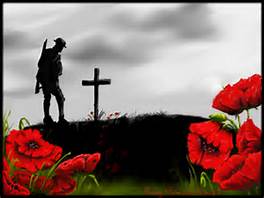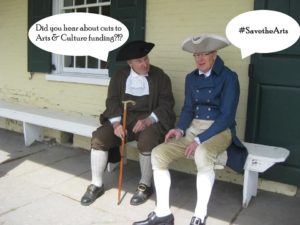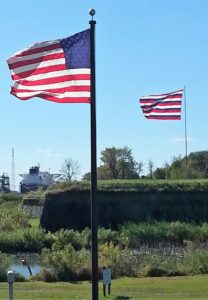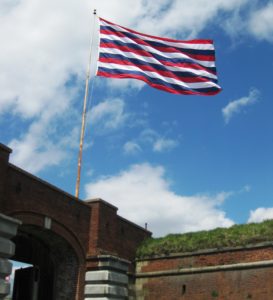 Many of our fellow Fort friends are service veterans and knew people that made the ‘supreme sacrifice’. We should remember and honor all those that have sacrificed their lives so that our country continues to be the beacon of freedom and opportunity.
Many of our fellow Fort friends are service veterans and knew people that made the ‘supreme sacrifice’. We should remember and honor all those that have sacrificed their lives so that our country continues to be the beacon of freedom and opportunity.
It is altogether fitting and proper that we should take a few moments to pay homage to all those men and women who have sacrificed their ‘tomorrows for our todays.’
Many of our older Friends are familiar with IN FLANDERS FIELDS; the World’s Most Famous War Memorial Poem by Lieutenant Col, John McCrae, Canadian Medical Corps.
On May 2, 1915, John McCrae’s close friend and former student Alexis Helmer was killed by a German shell. That evening, in the absence of a Chaplain, John McCrae recited from memory a few passages from the Church of England’s “Order of the Burial of the Dead”. For security reasons Helmer’s burial in Essex Farm Cemetery was performed in complete darkness.
The next day, May 3, 1915, Sergeant-Major Cyril Allinson was delivering mail. McCrae was sitting at the back of an ambulance parked near the dressing station beside the Yser Canal, just a few hundred yards north of Ypres, Belgium. He was the first person to ever read the poem and remarked, “The poem was an exact description of the scene in front of us both. He used the word blow in that line because the poppies actually were being blown that morning by a gentle east wind.”
On 29 September 1920, the National American Legion convened in Cleveland. The Convention agreed on the use of the Flanders Fields Memorial Poppy as the United States’ National emblem of Remembrance.
We invite you to read and contemplate the message of ‘In Flanders Fields’.
If you want to hear a YouTube recitation of the Poem by Sir John Gielgud click HERE
IN FLANDERS FIELDS
the World’s Most Famous War Memorial Poem
by Lieutenant Col, John McCrae,
Canadian Medical Corps
In Flanders fields the poppies blow
Between the crosses, row on row,
That mark our place: and in the sky
The larks still bravely singing fly
Scarce heard amid the guns below.
We are the dead: Short days ago,
We lived, felt dawn, saw sunset glow,
Loved and were loved: and now we lie
In Flanders fields!
Take up our quarrel with the foe
To you, from failing hands, we throw
The torch: be yours to hold it high
If ye break faith with us who die,
We shall not sleep, though poppies grow
In Flanders fields.
 These are challenging times for all of us – both personally and professionally. Visitor-facing cultural organizations have lost earned income streams with an uncertain future as communities recover from the pandemic and necessary shut-down.
These are challenging times for all of us – both personally and professionally. Visitor-facing cultural organizations have lost earned income streams with an uncertain future as communities recover from the pandemic and necessary shut-down.
Facing a recovery period against the backdrop of reduced or eliminated government support for arts and culture will mean that many organizations will be unable to recover. Think about how these organization enrich life for your family and imagine a world without many of them. This could be the future if we do not advocate for continued support of arts and culture in State and City budgets. Please contact your State Legislature representative and City Council representative and urge continued support for the Pennsylvania Historical and Museum Commission and the Philadelphia Cultural Fund.
Together we can #SaveTheArts.
 A symbol is something that represents or stands for something else – often an idea or abstract concept. The American flag is an easily recognized symbol of patriotism, its meaning extending beyond the 13 stripes for 13 colonies and 50 stars for 50 states. The federal courts determined that the American flag is “the symbol of our national unity, transcending all internal differences however large, within the framework of our Constitution.” This symbol of our national life goes to battle with soldiers, flies at sporting events, over post offices, schools and the White House. It honors fallen heroes inspires bravery and pride.
A symbol is something that represents or stands for something else – often an idea or abstract concept. The American flag is an easily recognized symbol of patriotism, its meaning extending beyond the 13 stripes for 13 colonies and 50 stars for 50 states. The federal courts determined that the American flag is “the symbol of our national unity, transcending all internal differences however large, within the framework of our Constitution.” This symbol of our national life goes to battle with soldiers, flies at sporting events, over post offices, schools and the White House. It honors fallen heroes inspires bravery and pride.
Francis Scott Key penned the Star Spangled Banner after being inspired by seeing the flag waving over Fort McHenry following intense British bombardment during the War of 1812. Years before, in 1777, the Fort Mifflin flag remained flying throughout the British throughout the siege and bombardment here.
Flag Day commemorates the official adoption of the flag of the United States by the Second Continental Congress on June 14, 1777. President Woodrow Wilson issued a proclamation honoring the anniversary of the flag resolution in 1916, and congress officially designated June 14 as National Flag Day in 1949.
The Fort Mifflin Flag
 The distinctive Fort Mifflin flag was also an official flag of the Continental Navy. Lacking the familiar blue union field of stars, it consists of alternating stripes of red, white and blue representing the thirteen states of the new nation. The flag typically flown at the Fort is a large garrison flag, about half the size of the flag at Fort McHenry flag of the War of 1812 (the “Star Spangled Banner”) and could be seen 7 miles away in Philadelphia.
The distinctive Fort Mifflin flag was also an official flag of the Continental Navy. Lacking the familiar blue union field of stars, it consists of alternating stripes of red, white and blue representing the thirteen states of the new nation. The flag typically flown at the Fort is a large garrison flag, about half the size of the flag at Fort McHenry flag of the War of 1812 (the “Star Spangled Banner”) and could be seen 7 miles away in Philadelphia.
During the siege and bombardment of Fort Mifflin (October 6 – November 15, 1777) the flag was kept flying despite the British bombardment, the greatest of the American Revolution. Although at one point British cannonballs were falling into the fort at the rate of 1,000 an hour, General Washington ordered the American garrison to “hold to the last extremity.” Two brothers from Pennsylvania, Sergeant Andrew Mackemson and Lieutenant James Mackemson, were both killed in re-raising the shot torn flag. The fort was finally evacuated by the last defenders early in the morning of November 16th, but was never surrendered to the British. The Fort Mifflin flag was still flying to the end.
Design your own flag! Click HERE to get some ideas and a special reward if you bring your flag to Fort Mifflin.
Want to learn more?
Learn how to respectfully handle the American Flag
Learn the story of the Star Spangled Banner
Betsy Ross or Francis Hopkinson?
 Many of our fellow Fort friends are service veterans and knew people that made the ‘supreme sacrifice’. We should remember and honor all those that have sacrificed their lives so that our country continues to be the beacon of freedom and opportunity.
Many of our fellow Fort friends are service veterans and knew people that made the ‘supreme sacrifice’. We should remember and honor all those that have sacrificed their lives so that our country continues to be the beacon of freedom and opportunity.

